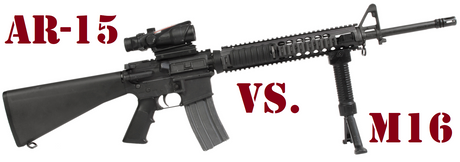AR-15 vs. M16: What's the Difference?
Posted by Gun Builders Depot on Sep 1st 2020
If you're a gun owner getting into the AR platform, you've already seen references to the M4 and M16, two military-issued rifles currently in service. These fully automatic rifles look identical to the typical AR-15. So, what are the differences? Let's break down these sibling weapon platforms.
AR-15 to M16: A Brief History
The AR-15 was designed in 1956 by Eugene Stoner of ArmaLite, an American small arms company based in California. This select-fire, air-cooled, gas-operated, magazine-fed rifle was designed to provide infantrymen with a new and lightweight rifle, one that could be carried more easily than the large 7.62mm NATO rifles then in use by the military. Facing financial difficulty, ArmaLite sold the AR-15 to Colt in 1959. Colt took the design and made some improvements to bolster accuracy and reliability. The rifle saw trials as part of a competition to replace the military's 7.62mm rifles. Based on the .308-caliber AR-10, the smaller AR-15 was favored by military brass for its maneuverability, ammo capacity, and surprising wounding ability.
Colt re-designated the AR-15 the M16A1 and provided it for service in Vietnam in 1964. The M16 was made by Colt to be little more than a fully automatic AR-15 but today, there are loads of configurations available for both rifles. The M4 carbine was later introduced, further blurring the lines between Stoner's semi- and fully automatic black rifles.
Shared Parts & Specs
These two rifles are nearly identical in materials and construction. Almost all their parts are directly interchangeable.
Upper Receiver Group

Both rifles' uppers share these parts:
- Barrel
- Gas block
- Gas tube
- Bolt
- Firing pin
- Upper receiver
- Charging handle
The mil-spec AR and M16 use forged 7075-T6 receivers. Almost all AR-15 barrels are made from 4150 (CMV) steel used in the M16's barrel. Both use the same stainless steel firing pins and gas tubes, and many AR-15s use the M16's front sight post/gas block combo shown above. Almost all AR-15s use an M16 bolt carrier group, too.
Lower Receiver Assembly

Both rifles' lowers share these parts:
- Buttstock
- Buffer tube
- Castle nut
- Buffer
- Recoil spring
- Pistol grip
Materials used in the lower receiver are almost identical here. The M16 and AR-15 use the same polymer buttstock, forged buffer tube, and forged aluminum (7075-T6) in their lowers. These are where the similarities between these two rifles end. Let's see how the M16 is different from the AR-15 and we'll also cover the M4 carbine.
Check out our guide on building a mil-spec AR-15.
AR-15 vs. M16: What's Different
There are three main parts which are different between these two rifles. Let's review how the magic happening inside the lower receiver separates the semiautomatic AR from the fully automatic M16.
The Lower Parts Kit
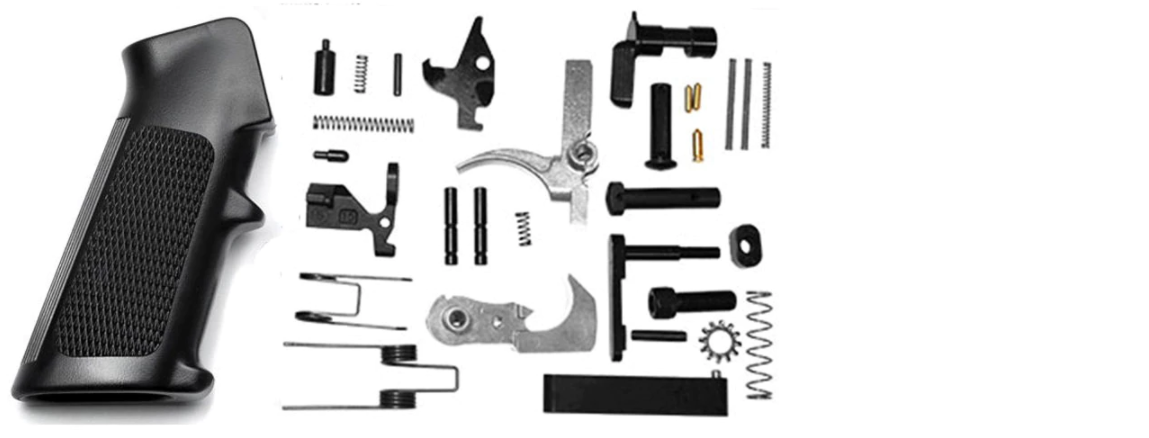
The M16's lower parts kit uses a different trigger, disconnector, hammer, and safety selector lever in tandem with an auto sear to provide three-round-burst and fully automatic fire. The AR-15's lower parts kit is not capable of providing these two functions and can only afford semiautomatic fire -- one round per trigger squeeze.
Hammer
The M16 hammer has an extra hook at the top which is caught by the auto sear.
Trigger
The M16 trigger has a small notch cut into the far end to accommodate the M16's disconnector.
Disconnector
The M16 disconnector has an extra "tail" behind its spring notch to work with the safety lever.
Safety Lever
The M16's safety lever is fabricated with extra channels and shoulders to provide safe, semi-, and full-auto function.
Auto sear
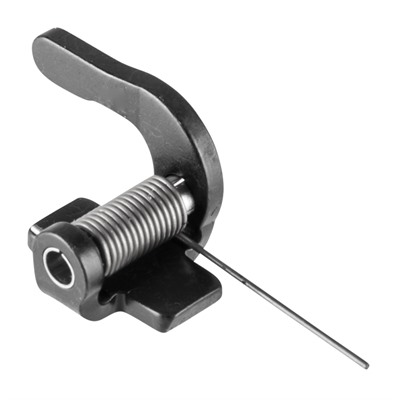
This little lever is the M16 auto sear. It rests above the safety lever and behind the hammer and trigger, allowing the M16 parts kit to provide all three modes of fire.
The Bolt
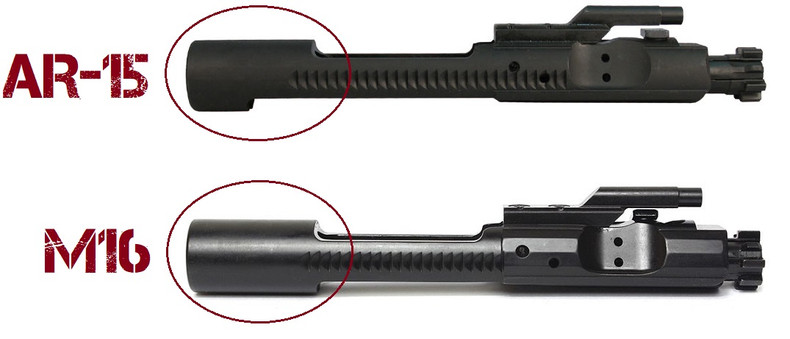
To allow the auto sear to provide full-auto function, the M16's bolt carrier must be fabricated different from an AR-15's "commercial" bolt carrier group. The extra mass at the back of the carrier interacts with the sear and helps to reduce felt recoil during full-auto fire.
The Lower Receiver
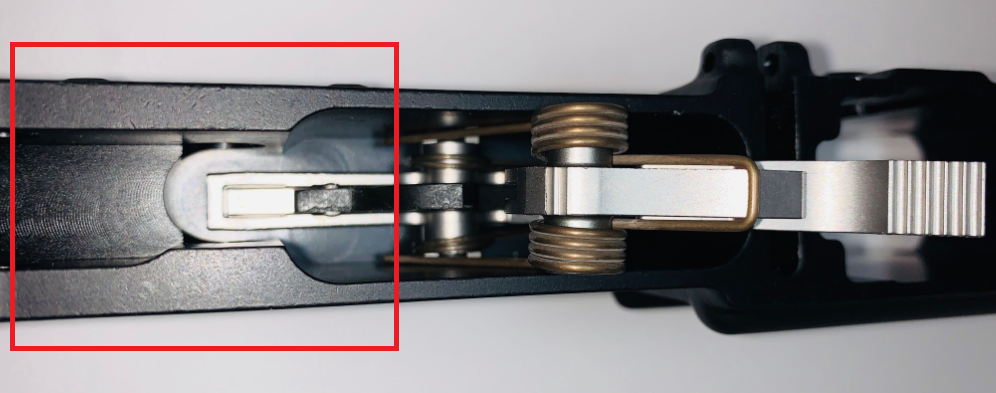
Shown with the safety lever removed, the AR-15's lower receiver (even if "mil-spec") does not have the necessary space to accept an M16's auto sear. The portion highlighted in red must be milled or cut to make room for the sear. Doing so is illegal, since machineguns cannot be manufactured without special licensing and case-by-case approval from the ATF.
There have been "drop-in" auto sear (DIAS) units made for the AR-15 by licensed FFL manufacturers for the AR-15's receiver, but these are not available for sale to the public and installing or using is still prohibited without licensing.
M16 vs. M4
Now you know the AR and M16 are more similar than they are different. But the M4 carbine, introduced in the 1980s, is yet another departure from the AR's original design. The only difference between the M4 and M16 is barrel length. The M16 was always fitted with a 16" to 20" barrel. The M4 carbine exclusively uses a 14.5" barrel. The minimum legal length on a civilian rifle is 16" unless you file paperwork to own a short-barreled rifle (SBR).
Frequently Asked Questions
There are endless questions when it comes to this topic, but we tried to answer the most common ones.
Q: Can I legally build an M16 from an AR-15?
A: No. Unless you're a Class 3 FFL, you can't build a machinegun. That includes using an 80% lower.
Q: Can I install any M16 parts kit in my AR-15?
A: No. The differently shaped parts generally prohibit the kit from being installed in a commercial lower.
Q: Is owning any M16 parts illegal?
A: No. You can legally use M16 parts on your AR-15 like the bolt carrier, but you cannot own an auto sear and a rifle. Owning these parts together is called "constructive intent" and is illegal under federal law.
Q: Can I just buy a full-auto M16?
A: Sure, if you have around $25,000. That's the going price for an early Colt M16 transferable machinegun. As inventory dries up, prices will continue to climb.
DISCLAIMER: If you are new to the world of DIY gun building, you likely have a lot of questions and rightfully so. It’s an area that has a lot of questions that, without the correct answers, could have some serious implications. At GunBuilders.com, we are by no means providing this content on our website to serve as legal advice or legal counsel. We encourage each and every builder to perform their own research around their respective State laws as well as educating themselves on the Federal laws. When performing your own research, please be sure that you are getting your information from a reliable source.

